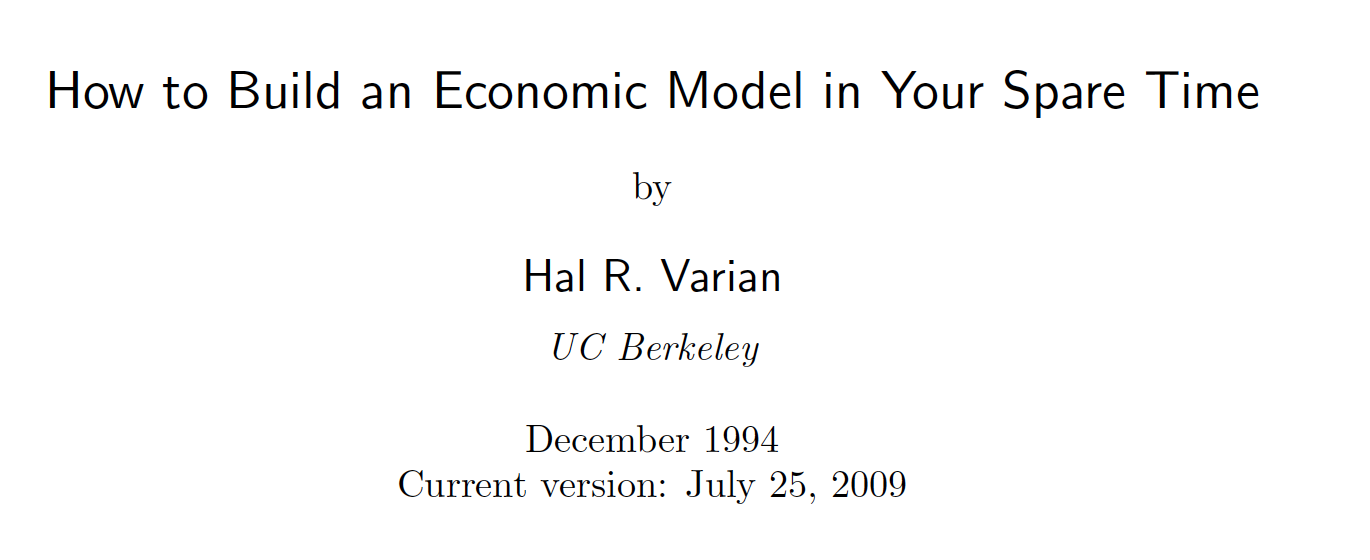Hal Varian’s timeless insights on thinking
 In December of 1994, economist Hal Varian, who is currently Google’s chief economist, wrote a paper called “How to Build an Economic Model in Your Spare Time.” Ignore the subject matter. It should have been called “How to think clearly.” His advice hasn’t lost relevance in the 21-plus years since he wrote it. (Thanks to Cory Doctorow at BoingBoing for unearthing this gem.)
In December of 1994, economist Hal Varian, who is currently Google’s chief economist, wrote a paper called “How to Build an Economic Model in Your Spare Time.” Ignore the subject matter. It should have been called “How to think clearly.” His advice hasn’t lost relevance in the 21-plus years since he wrote it. (Thanks to Cory Doctorow at BoingBoing for unearthing this gem.)
Here are a few choice excerpts. Just substitute your field where it says “economics” and the insights will reveal themselves.
Getting and testing ideas
The first step is to get an idea. This is not all that hard to do. The tricky part is to get a good idea. The way you do this is to come up with lots and lots of ideas and throw out all the ones that aren’t good.
Most graduate students are convinced that the way you get ideas is to read journal articles. But in my experience journals really aren’t a very good source of original ideas. . . . I think that you should look for your ideas outside the academic journals — in newspapers, in magazines, in conversations, and in TV and radio programs. When you read the newspaper, look for the articles about economics . . . and then look at the ones that aren’t about economics, because lots of the time they end up being about economics too . . . Conversations, especially with people in business, are often very fruitful.
Regardless of your topic, ideas are everywhere. If you read what other experts write, you’ll think as they do. If you seek inspiration in the real world, you’ll see what others didn’t.
How do you know if [your idea] is any good? The first test is to try to phrase your idea in a way that a non-economist can understand. If you can’t do this it’s probably not a very good idea. If you can phrase it in a way that a noneconomist can understand, it still may be a lousy idea, but at least there’s hope.
[T]ry it out on a few people — see if they think that it is worth pursuing. What would follow from this idea if it is correct? Would it have lots of implications or would it just be a dead end?
If you want to find out if your idea is stupid, this is the way to do it. Assuming it’s not stupid, you’ll have to figure out on your own if it’s smart.
Complexity is easy, simplicity is hard

Several years ago I gave a seminar about some of my research. I started out with a very simple example. One of the faculty in the audience interrupted me to say that he had worked on something like this several years ago, but his model was “much more complex”. I replied “My model was complex when I started, too, but I just kept working on it till it got simple!”
And that’s what you should do: keep at it till it gets simple. The whole point of a model is to give a simplified representation of reality. Einstein once said “Everything should be as simple as possible . . . but no simpler.” A model is supposed to reveal the essence of what is going on: your model should be reduced to just those pieces that are required to make it work.
This is a good framework for any analytical thinking. Keep removing complexity until you have it down to the bare bones. Anyone should understand it.
I had this conversation once with my cousin Len Burman, who is a well-known economist. He was amazed at the relative simplicity of the spreadsheet-based models we used at Forrester to project technology adoption. He told me that economists’ economic models “are a lot more complex . . . but of course, they’re usually wrong six months out, anyway.”
Testing ideas with a speech
After you’ve bored your friends, relatives and pets to death, you should give seminar. This is a really important phase: the more you can talk about your work, the better the final paper will be. This is because a talk forces you to get to the point. If you want your audience to listen to you, you’ve got to make your idea clear, concise, and organized — and the experience that you gain by doing this is extremely useful for writing your paper.
The useful thing about a seminar is that you get immediate feedback from the audience. An audience won’t put up with a lot of the things that authors try to write in papers: turgid prose, complex notation, and tedious details. And, believe it or not, readers won’t put up with these things either!
We get (or used to get) a lot of musicals in Boston that might eventually get to Broadway. It’s the “off-Broadway tryout.” And it’s worth doing. That’s how musicals (and ideas) get better.
My advice about introductions is simple: don’t have one. I have seen many seminars ruined by long, pretentious, contentless introductions. My advise: say a few sentences about the big picture and then get down to business: show them what you’ve got and why it’s important. The primary reason to get down to business right away is that your audience will only remember about twenty minutes of your talk — and that is usually the first twenty minutes.
Introductions. Avoid them. Not just in seminars, but in writing.
How to write
After organizing these ideas for several weeks or months I am ready to write the first draft of the paper. I usually try to do this in a day or two, to keep it all fresh. I normally put the notes in one [on-screen] window and the paper in the other . . . Once the paper is written I put it aside for a couple of weeks. Papers need to age like fine cheese — it’s true that mold might develop, but the flavor is often enhanced. More importantly, it gives your subconscious mind a chance to work on the idea — maybe it will come up with something your conscious mind has missed.
When I come back to the paper I try to read it with a fresh mind, like someone who has never seen it before. On rare occasions I like what I read, but usually I have lots of criticisms. Whenever I have to pause and think “what does that mean?” I rewrite — I add more explanation, change the notation, or whatever is necessary to make the paper clearer.
Takeaways: Gather all notes before you begin to write. Write drafts quickly. Let them sit and come back and improve. All excellent advice.
It’s amazing how much of wisdom is recycled. The key is not to forget what remains true. So thanks to Hal Varian for the wisdom, and thanks to Cory Doctorow for reminding us about it.